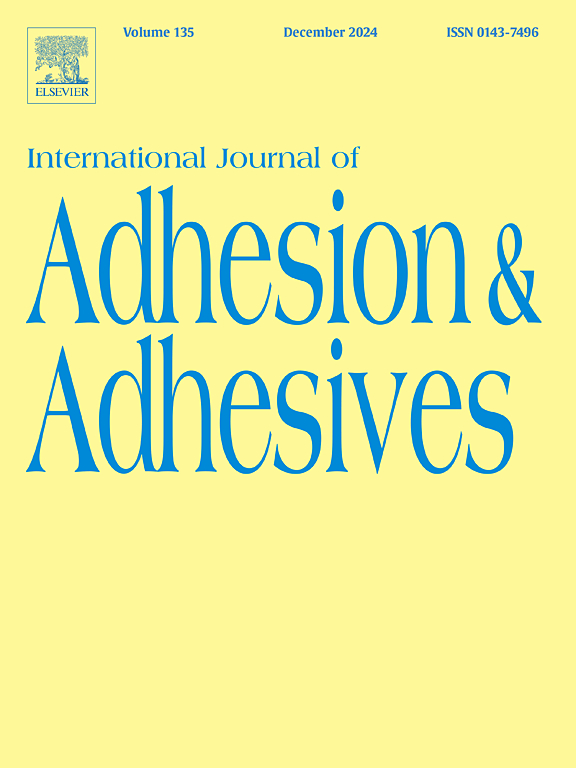A study on the effects of electrochemical oxidation and silane modification applied to fibers in short carbon fiber-reinforced structural adhesives and adhesive joints
IF 3.2
3区 材料科学
Q2 ENGINEERING, CHEMICAL
International Journal of Adhesion and Adhesives
Pub Date : 2025-03-25
DOI:10.1016/j.ijadhadh.2025.104020
引用次数: 0
Abstract
In this study, electrochemical surface treatment and various silane modifications were applied to fiber structures incorporated into adhesives to enhance the performance of bonded systems. Initially, electrochemical oxidation was performed on the fibers added to the adhesive, increasing the active oxygen groups on their surfaces. Subsequently, silanization was carried out using 3-aminopropyltriethoxysilane (APTES) and glycidoxypropyltrimethoxysilane (GPTMS) as silane agents, improving the surface energy of the fibers. The structural adhesive used in the study was a two-component epoxy adhesive. Composite adhesives were prepared by incorporating carbon fibers treated with electrochemical oxidation and silane modification at weight fractions of 1 %, 2 %, 3 %, and 4 %, and adhesive joints were fabricated using these modified adhesives. According to the results of surface wettability experiments, carbon fibers cleaned with acetone exhibited highly hydrophobic behavior, while fibers subjected to electrochemical oxidation displayed highly hydrophilic behavior. However, subsequent silanization treatments following electrochemical oxidation transformed the surface wettability of the fibers to hydrophilic behavior. Furthermore, the application of electrochemical oxidation to the fibers increased the adhesive's nominal maximum stress value by approximately 126 %, while subsequent silanization treatments following electrochemical oxidation enhanced the nominal maximum stress value by approximately 177 %. These improvements are also supported by the results obtained from shear tests, with the degree of enhancement varying depending on the fiber content added to the adhesive. Changes in the surface functional groups and surface morphologies of the samples were analyzed using X-ray photoelectron spectroscopy (XPS), Fourier-transform infrared spectroscopy (FTIR), and scanning electron microscopy (SEM) imaging.

电化学氧化和硅烷改性对短碳纤维增强结构胶和粘结接头纤维的影响研究
在本研究中,电化学表面处理和各种硅烷改性应用于粘合剂中的纤维结构,以提高粘合体系的性能。最初,对添加到粘合剂中的纤维进行电化学氧化,增加其表面的活性氧基团。随后,以3-氨基丙基三乙氧基硅烷(APTES)和甘氧基丙基三甲氧基硅烷(GPTMS)为硅烷剂进行硅烷化,提高了纤维的表面能。本研究使用的结构胶粘剂为双组分环氧胶粘剂。分别以1%、2%、3%和4%的质量分数对碳纤维进行电化学氧化和硅烷改性,制备复合胶粘剂,并用改性后的胶粘剂制备粘接接头。表面润湿性实验结果表明,丙酮清洗后的碳纤维表现出高度疏水性,而电化学氧化后的碳纤维表现出高度亲水性。然而,电化学氧化后的硅烷化处理将纤维的表面润湿性转变为亲水性。此外,电化学氧化对纤维的应用使粘合剂的标称最大应力值提高了约126%,而随后的电化学氧化后的硅化处理使标称最大应力值提高了约177%。这些改进也得到了剪切试验结果的支持,增强程度取决于添加到粘合剂中的纤维含量。利用x射线光电子能谱(XPS)、傅里叶变换红外光谱(FTIR)和扫描电镜(SEM)成像分析了样品表面官能团和表面形貌的变化。
本文章由计算机程序翻译,如有差异,请以英文原文为准。
求助全文
约1分钟内获得全文
求助全文
来源期刊

International Journal of Adhesion and Adhesives
工程技术-材料科学:综合
CiteScore
6.90
自引率
8.80%
发文量
200
审稿时长
8.3 months
期刊介绍:
The International Journal of Adhesion and Adhesives draws together the many aspects of the science and technology of adhesive materials, from fundamental research and development work to industrial applications. Subject areas covered include: interfacial interactions, surface chemistry, methods of testing, accumulation of test data on physical and mechanical properties, environmental effects, new adhesive materials, sealants, design of bonded joints, and manufacturing technology.
 求助内容:
求助内容: 应助结果提醒方式:
应助结果提醒方式:


